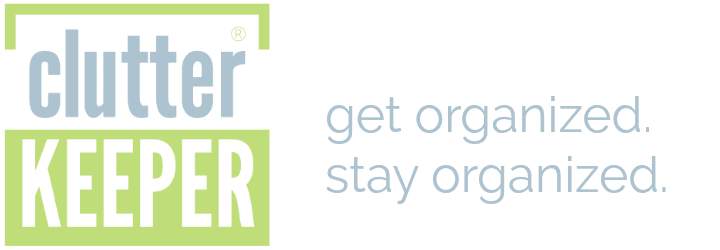Pantry Organization: Your Complete Guide
THIS POST MAY CONTAIN AFFILIATE LINKS. PLEASE SEE OUR FULL DISCLOSURE POLICY FOR DETAILS.
Completely organize your pantry and discover how to find all the food you are storing. Learn professional pantry organization techniques you can use.
One of the hardest places to keep organized in the kitchen is the food pantry. It seems like it just keeps getting crammed with food. Things get lost and it’s difficult to find ingredients when you need it.
This guide is going to help you completely transform your pantry so you can discover more storage than you ever knew you had.
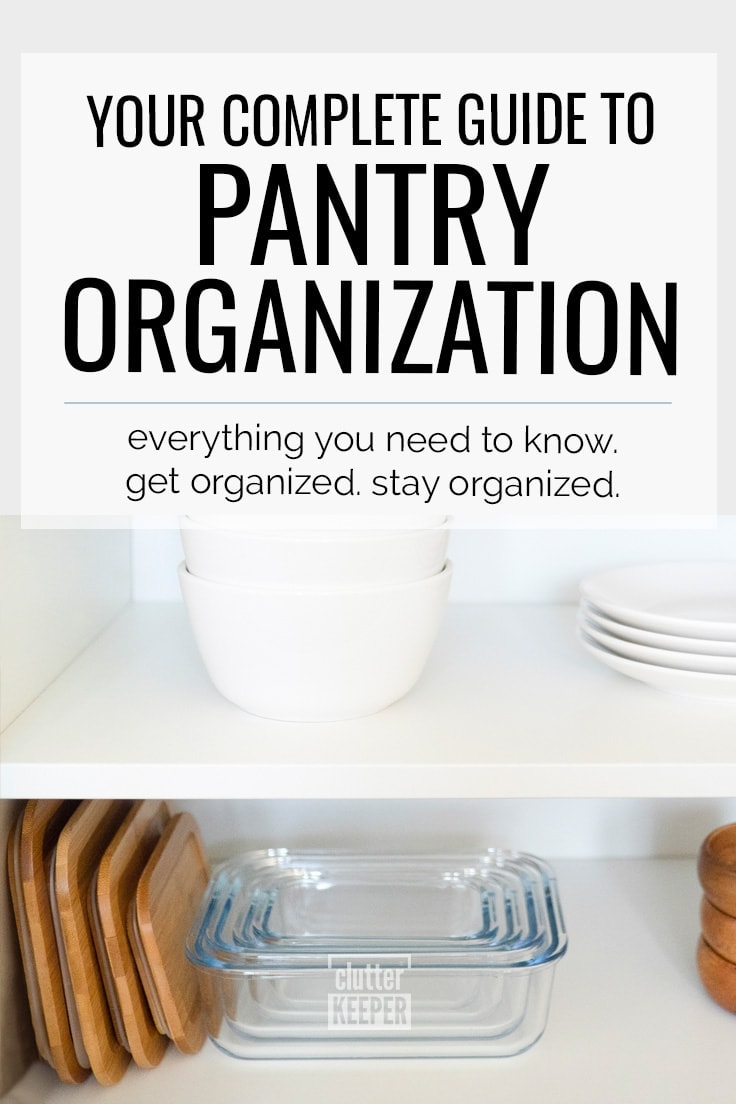
Wondering where to begin? Get our FREE guide, The 30-Minute Organizing Secret, and discover easy ways to overcome the chaos of clutter – even with kids at home!
Pantry Organization: Your Complete Guide
Solve the problem of pantry storage issues in your home with this complete guide. I’ll take you step by step through your pantry and help you take it from chaotic to calm!
After you conquer the pantry, use the Take Back Control book to revamp the rest of your kitchen!
Table of Contents
- How To Organize Your Pantry Step-by-Step
- What To Keep In Your Pantry
- How Long To Keep Things In Your Pantry
- Pantry Food Storage Containers
- Canned Food Storage Ideas
- How To Label Food Containers
- How To Store Food Without A Pantry
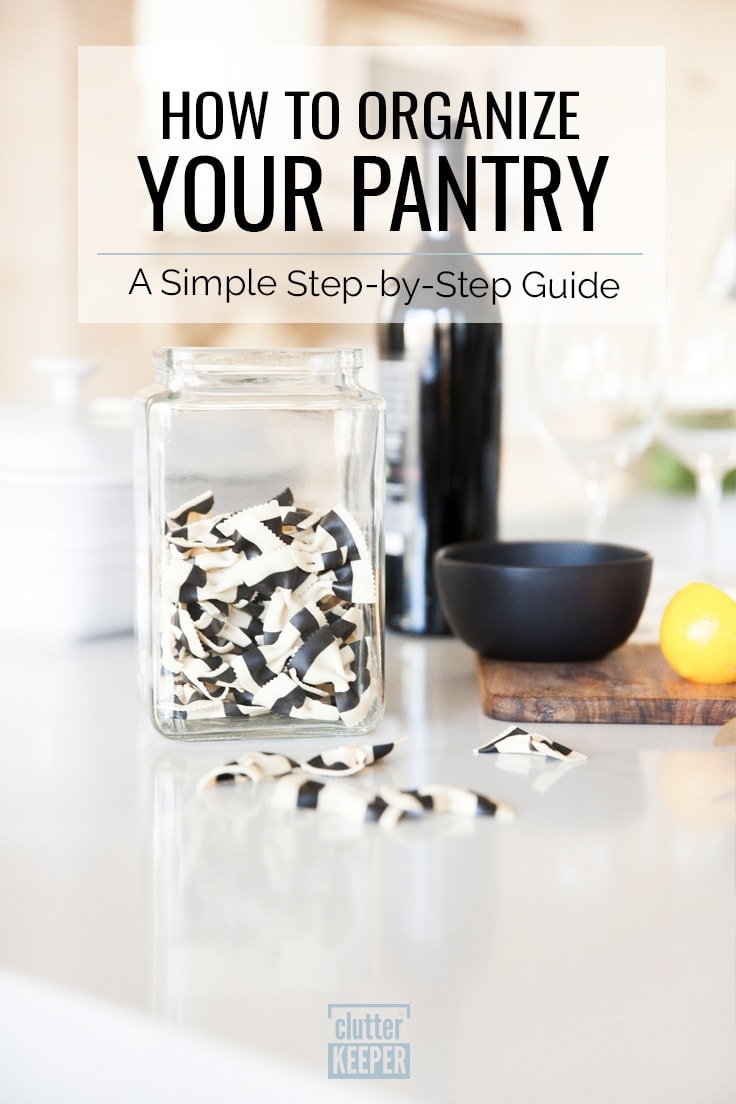
How To Organize Your Pantry Step by step
Many of the professional organizers we spoke with said the most common area they are hired to organize is the kitchen pantry. So many people don’t know what to do with their pantries. It’s just a place where the food stays until it’s time to cook and it’s really easy for it to get out of control.
Thankfully, organizing your pantry really can be done – and you can keep it that way too. The entire process can be done in just one day.
Here are some proven steps that will help you tame your food storage mess. You might even make your pantry one of your favorite closets in your house!
1. Take Everything Out
The very first step is to literally take every single thing out of your pantry. Put everything on your kitchen table and on the counter tops.
At this step you will be able to take an inventory of everything you own. You’ll be able to see what you will keep and what you can throw or give away. You might even find something that you thought was lost!
2. Throw away anything that is expired
Next, take inventory of everything that you pulled out of the pantry. Look closely at all of your food and throw away anything that is expired or stale.
The goal of this step is to only keep food that is edible. It might surprise you how much storage space you have just by getting rid of the food that isn’t good anymore.
3. Donate food you won’t eat
Make another pile of food that your family refuses to eat. Maybe you bought that can of lima beans, only to discover that your children don’t like lima beans. It happens.
Put all the food you know your family won’t eat into another box that you’ll take to your local food pantry. Remember, only take food that is unopened.
This is why you need our Printable Meal Planner. You can track your pantry’s inventory and know what you need to donate before it expires.
4. Clean the Pantry
Now you are ready to give everything a good cleaning. Grab a washcloth, soap, and water, and begin wiping down the shelves. Vacuum all the dust and bits of food that might have spilled.
While you have your rag out, wipe down all the bags of food, too. If anything is sticky or has dust on it, clean it.
Before you put anything back in the pantry, you want to make sure everything is clean and spotless.
5. Sort food into zones
Now that everything is cleaned off, begin sorting the food that you kept. Separate them into logical food groups.
This step will make it easier to put things back in your pantry in an organized way.
What are food zones? They are logical groups of food that describes how you use the food. Here are some examples:
- Snacks
- Baking Ingredients
- Sauces
- Canned Foods
- Cereals
- Dry Goods
6. Use containers and organizers
Next, look at your groups or zones and decide what kinds of containers or organizers you will need. If you aren’t sure, scroll down a little bit, I shared some food organizing ideas.
Some people like to use this chance to order the organizers and then put the food back in the pantry while they wait for the items to arrive at their house. You can also go directly to the store and buy what you need that day.
No matter which choice you make, this is the step where you decide what types of baskets and organizers you need.
7. Label everything
After sorting all of your food into zones, you will know which groups will need labels. Anything that you keep in containers or baskets will need a label.
Not only will it help the entire pantry look more uniform, but it will help everyone keep the pantry organized too. When they can read and see where things belong, they will be more likely to keep them there.
8. Store non-food items somewhere else
Finally, look at all of the non-food items that you pulled out of your pantry. Try to find another storage location for as many of them as you can.
The goal here is to keep only food in your pantry, if you can. Prevent this area from becoming a “catch-all” for anything in your house.
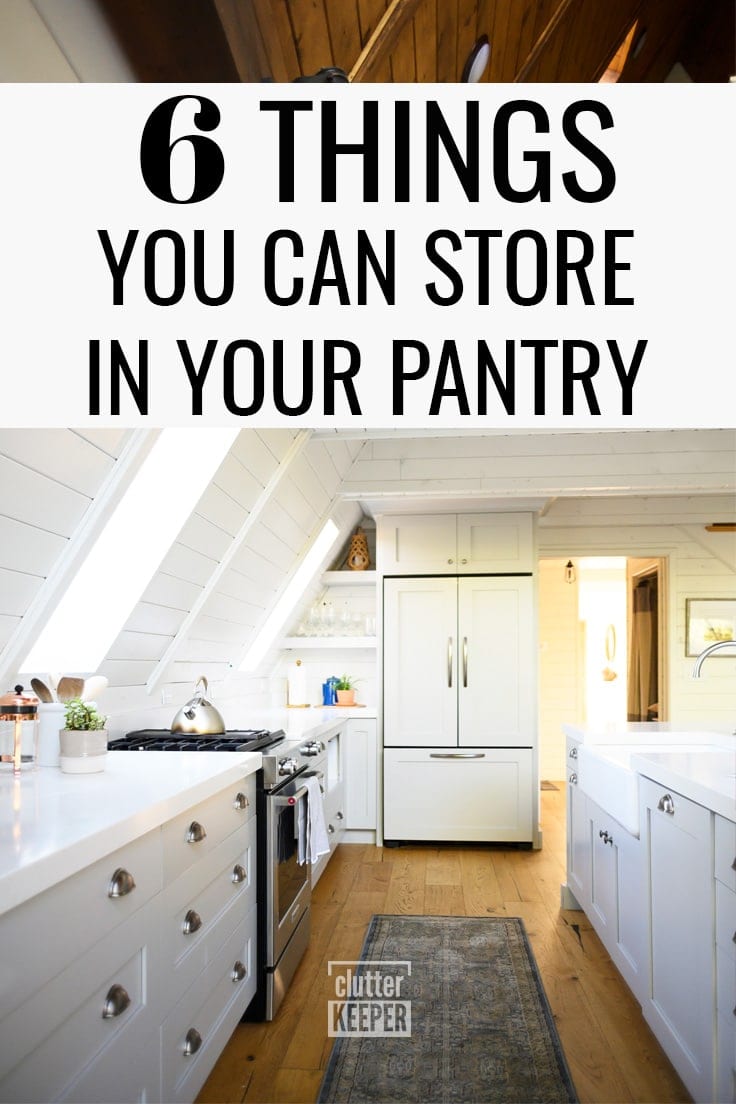
What To Keep In your pantry
So, what should you keep in your pantry? Basically, this should be the place where you store all of your shelf-stable foods and anything else that is food-related.
The best way to decide what to keep in your pantry is to organize everything into zones. Here are some of the most popular pantry categories or zones and what belongs in them.
Snacks
Snacks describes anything that anyone eats in between meals. This can include chips, cookies, fruit snacks, and toaster pastries.
Dry Goods
Dry goods describes food that can be stored at room temperature. Lots of people use this term when they are talking about rice, beans, and other grains.
Here are some examples of dry goods:
- Rice
- Dry beans
- Cereals
- Pasta
- Tortillas
Canned Foods
The next category is self-explanatory. Anything in a can belongs here. When you store them, try to keep everything sorted together. That means keep cans of fruit together, cans of beans, and cans of vegetables.
Then, keep each type of fruit and vegetable sorted too. So keep all the cans of corn together and the cans of peas together.
By organizing them in this way you will be able to find exactly what you need in no time at all.
Baking and cooking ingredients
Another common category of pantry food are the baking and cooking ingredients. This includes flour, sugar, and spices.
These ingredients are better to be kept inside resealable containers that way they don’t spill and you can label them clearly too.
jars and sauces
Jars and sauces are another really common category. This includes gravies, marinara sauce, salsa, and enchilada sauces. Keep them all organized and keep the identical sauces stored together.
Kitchen appliances
Finally, some people keep kitchen appliances in their pantry. This is a smart place to keep them, especially if you don’t have anywhere else to store them. Just make sure and only keep the appliances that you actually use.
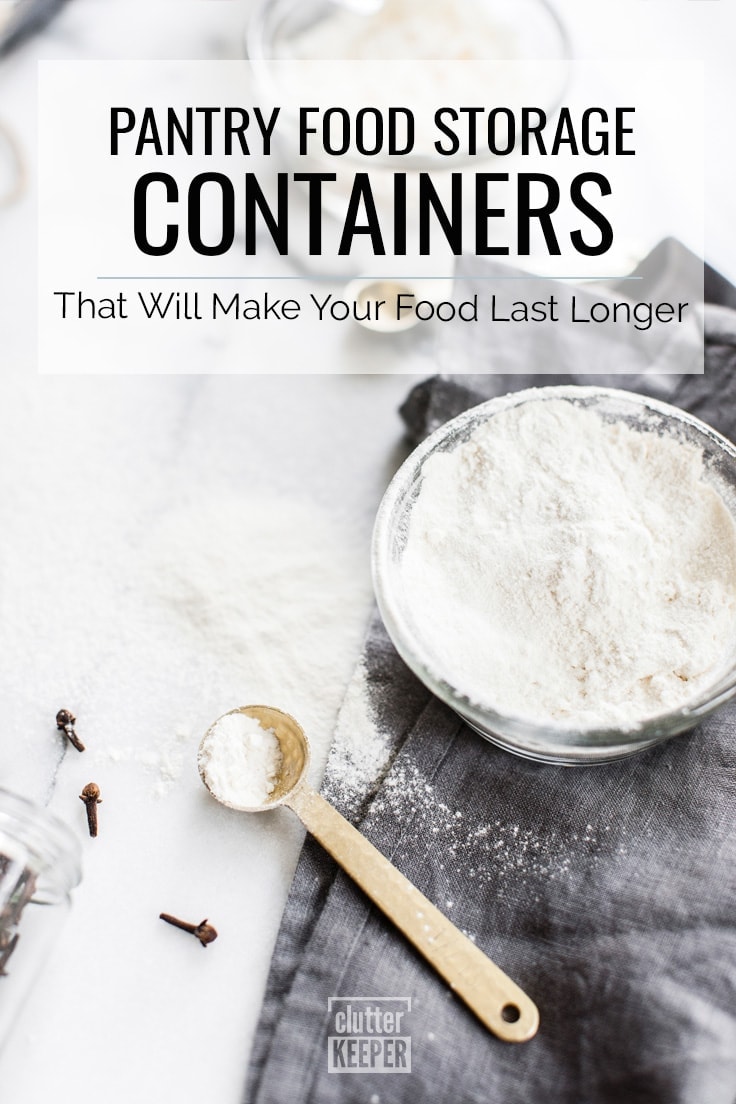
How Long to keep things in your pantry
Now that you know what to keep in your pantry, how long will they last? Here’s a quick overview of the shelf-life of food in your pantry.
Shelf life of pantry foods:
- Rice – 2 years
- Dried Beans – 1 year
- Canned Food – 2-5 years
- Cereals – 6-8 months past date on the box
- Sauces – 12-18 months
- Soda – 3 months after expiration date
- Flour – 6-8 months
- Nuts – 4-6 months
- Sugar – indefinitely
- Tea Bags – 12-18 months
Pantry Food Storage Containers
The bags that you buy rice, beans, and pastas in aren’t set up to be long-term solutions. Instead, look for some food storage containers that you can keep sealed. This will help your food last longer and prevent spills too.
Here are a few of our favorite food storage containers:
- Cereal Storage Set
- Food Storage Containers for Pasta
- Flour and Baking Ingredients Containers With Scoops
When you are choosing containers, buy the ones that seal completely. This will keep your food fresh for longer.
Canned Food Storage ideas
When you are trying to store cans of food in your pantry, think beyond just stacking them. There are lots of inexpensive products out there that will keep your cans sorted and where you can easily find them.
Here are some of our favorite ones.
Raised Step Shelf
A really easy way to keep cans where you can see them is by setting them on a raised step shelf. They are affordable options at less than $10. Plus, they give you more room in your pantry and make it look so pretty at the same time.
Canned Food Rack
There are lots of different canned food racks you can buy. Measure your space and buy the one that fits in your pantry the best.
The best thing about these racks is that they keep your cans from spilling or falling down. Plus, you can see all of your cans at one time.
The most important thing to remember when you are trying to store cans is to buy a storage product that fits in your pantry or cabinet. Measure your space first before spending the money, that way you know it will fit.
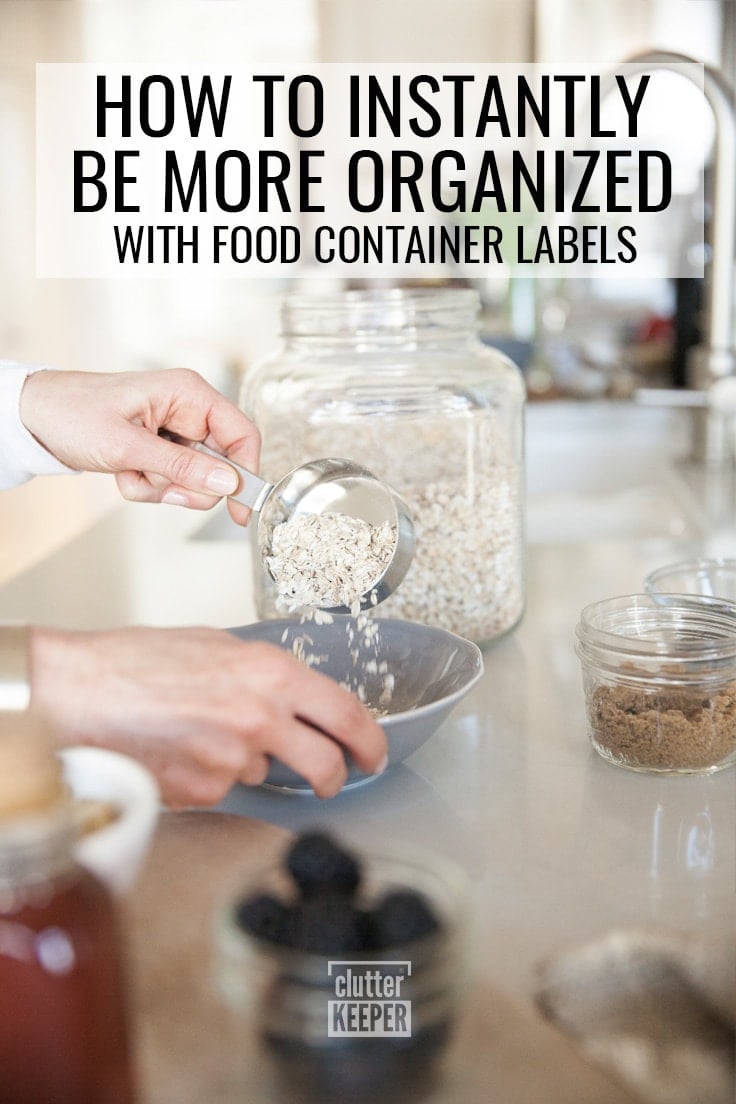
Pantry Organization – Label Food Containers
Jars and containers will help your dry goods last longer and prevent spills in your pantry. As a bonus, they also look stunning in your pantry! Talk about something to brag about!
If you choose to put your ingredients in matching jars and containers, you should label them. I found a few examples of different ways to label your containers, pick your favorite.
Label machine
Using a label maker is one of the easiest way to label your jars. They all end up looking uniformed and easy to read. Plus, the labels are adhesive, so they stick to any container you use.
Cricut Labels
Another really popular way to label containers is with vinyl letters made with a Cricut machine. As you can see in the photo below, the font and letters are much more creative.
These are a lot of fun to create. People all over rave about how much they love using their Cricuts. This is just one more way to use them around the house.
Chalkboard labels
Another option is you can write out labels on chalk board adhesives. If you don’t think your handwriting is good enough you can also purchase labels from people on Etsy too.
It doesn’t matter which option you choose, as long as you label the containers and try to keep them all matching and uniform.
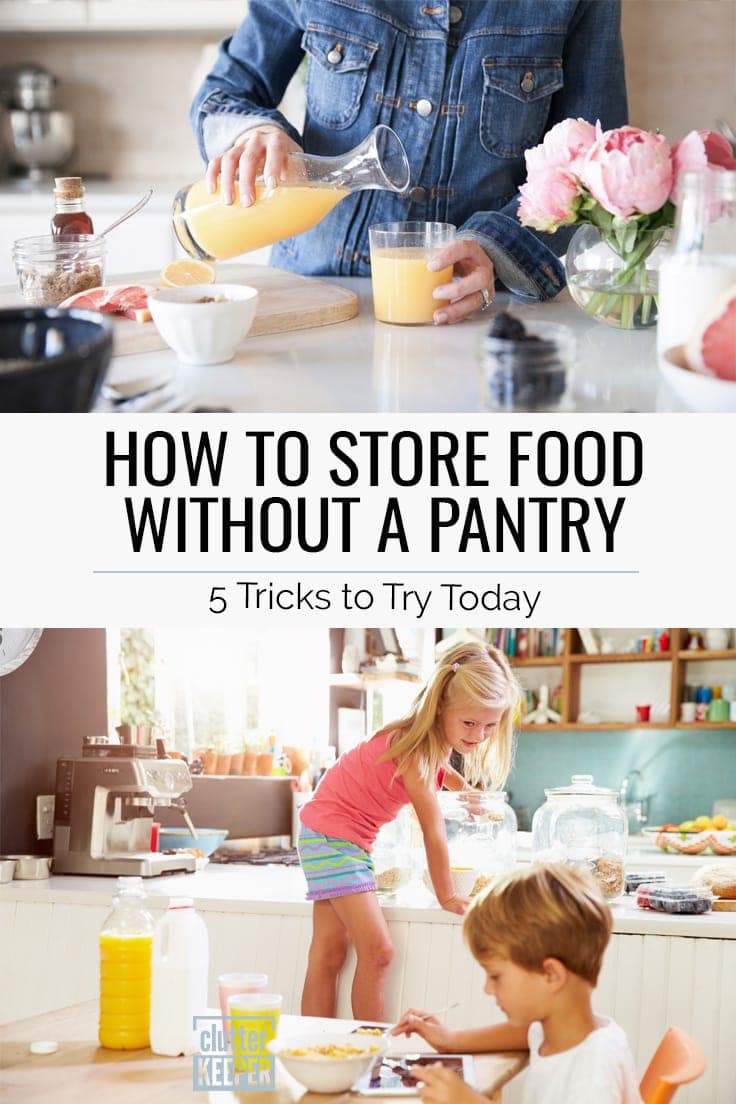
How to store food without a pantry
Do you live in a small house or apartment that doesn’t have a dedicated pantry? Here are some tips that can help you turn your kitchen cabinets into an organized food storage solution. Pantry organization is possible, even without a walk-in pantry. Here’s how!
1. maintain food zones
First, no matter how small your food storage location is, you need to keep food zones separated and organized. Keep your canned foods in one spot, your dry goods in another, and the snacks in another.
Here are some more small kitchen tips that will help you keep everything organized.
2. Utilize baskets
Next, store these foods in separate baskets. If you do this, you could keep them in any cabinet or even on the counter. Plus, you can pull out each basket separately without having to search through a cluttered cabinet.
3. Label Things
After you put things in baskets together, label the baskets. This will help you keep them organized long term. Plus, when the baskets are labeled you will be able to find exactly what you need quicker.
4. Keep things together
One of the most important rules in organizing is to try and keep everything sorted in like groups. That’s why baskets, bins, and labels are so important.
5. Maintain Your Pantry Organization systems
Finally, set a regular maintenance schedule. About once every few months, go through and assess your storage systems. Ask yourself if they are still working. If your needs change, then buy some new baskets. It’s important to make your systems work for you instead of trying to cram everything in the old bins.
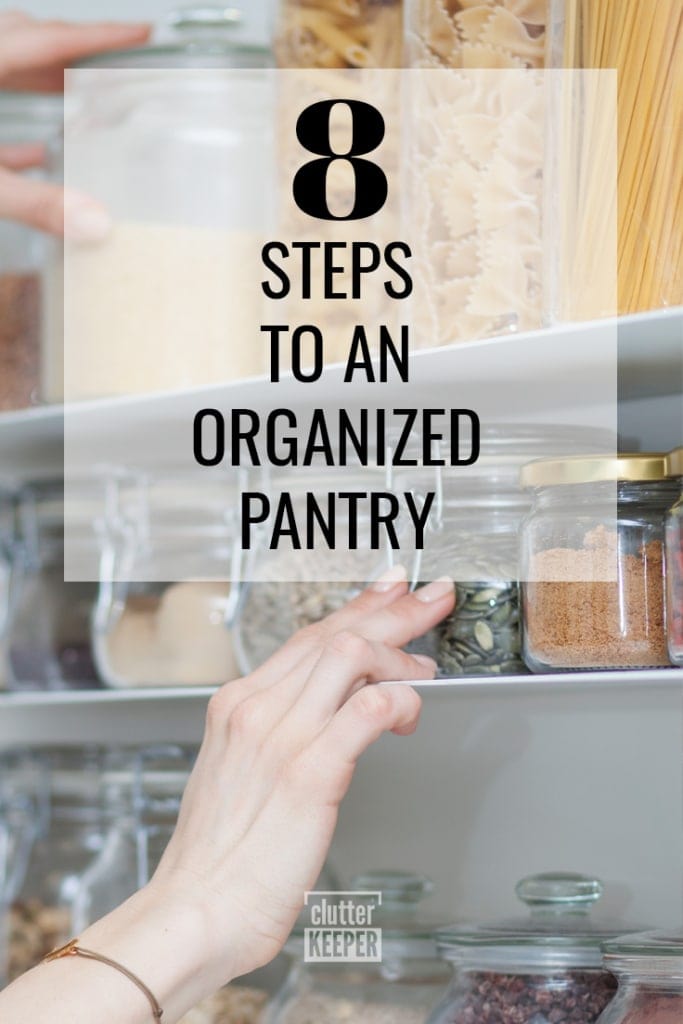
Pantry Organization Final Thoughts
The pantry is one of the most rewarding places in the kitchen to organize. It’s such a small area that you can accomplish this in less than a weekend. In fact, once you tackle the pantry organization, there’s no stopping you! You can begin organizing your kitchen cabinets and other closets in your home.
Do what works for you. Keep only what you need and store things in a way that makes them easier to find. You are well on your way to a home that you can get organized and keep organized – for good!
Struggling to get motivated? Sign up to get our FREE guide, The 30-Minute Organizing Secret, and discover easy ways to overcome the chaos of clutter – even with kids at home!
More kitchen organization ideas
Here are some more kitchen organization ideas and tips as you sort through your pantry.
